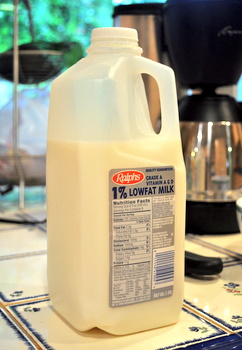



However, a few recent studies have claimed that drinking skimmed milk may, in fact, have the reverse effect and could actually lead to weight gain. Patel - Nutritive Value of Skim Milk (100 ml - Cow Milk)įat - 0.1 gm Nutritive Value of Whole Milk (100 ml - Cow Milk)įat - 4.48 gmWhile skimmed is not as nutritious as compared to whole milk, people often opt for skimmed milk as it is known to help with weight-loss. Although these vitamins are in the fat of the milk, skim milk is fortified with vitamin A and D during the fat removal process." Whole milk Vs skimmed milkHere are the nutritive values of both whole and skimmed milk as suggested by Dr. Whole milk contains fat-soluble vitamins like A, D, E and K. Zamurrud Patel, Nutritionist at Global Hospitals, Mumbai, agrees, "People looking to lose weight should try skim milk.

#Skim milk vs whole milk full#
Also, skimmed milk has slightly more calcium and protein when compared to full fat milk and has no added sugar."ĭr. A glass of full fat milk might contain up to 10 grams of fat and roughly 176 Kilo-calories (Kcal) whereas the same amount of skimmed milk might contain somewhere between 2 grams to 0 gram of fat and somewhere between 89-118 Kilo-calories (Kcal). Sunali Sharma, Dietitian & Nutritionist, Amandeep Hospital, "Skimmed milk or low fat milk is great if you are planning to curb your calorie intake. Many health experts vouch for non-fat milk, considering it is calorie-free and light on your tummy. It is not as 'creamy' as whole milk and appears lighter and thinner in consistency.
#Skim milk vs whole milk free#
What is skimmed milk?Skimmed milk is generally free from dietary fat or is fat free and has less than 0.5 gram of fat with no added ingredients containing fat. But is it really helpful in reducing weight? And what about the nutrition index? Let us look at both the sides of the coin. Basically, skimmed milk is milk with no fat and therefore considered ideal for those trying to lose weight. The last one seems to have emerged as a favourite of the calorie conscious. Lately, supermarket shelves are full of all types of milk varieties - there is full cream, toned, double toned and skimmed. And then there’s the possibility that for certain high fat dairy foods, like cheese, which is fermented, microbes may be working to improve insulin response and lower diabetes risk too.Milk forms an essential part of our daily lives thanks to its nutritious properties and a healthy dose of calcium, we've always been advised to have at least 2 glasses of milk everyday by our parents and elders. It’s also possible that the fats in dairy may be acting directly on cells, working on the liver and muscle to improve their ability to break down sugar from food. At the simplest level, people eating more high fat dairy products will have enough calories so they won’t feel hungry enough to need additional calories from sugary foods. While it’s not entirely clear how whole fat is helping to lower risk of diabetes, it’s possible that it’s working on several different levels to regulate insulin and glucose. “It’s crucial at this time to understand that it’s about food as a whole, and not about single nutrients.” “This is just one more piece of evidence showing that we really need to stop making recommendations about food based on theories about one nutrient in food,” says Mozaffarian. MORE: This Is the Worst Kind of Fat for Your Heart But by focusing just on cutting out fat, experts didn’t count on the fact that people would compensate for the missing fat and start loading up on carbohydrates, which the body converts into sugar-and then body fat. When dietary guidelines began urging people to lower the amount of fat they ate, the idea was to reduce the amount of cholesterol and unhealthy fats in the body. Together, the body of data is beginning to reveal both that full-fat dairy has a place in a healthy diet, and also how focusing on one nutrient in the diet may backfire. In fact, in a separate study published in the American Journal of Nutrition, another group analyzed the effects of full fat and low fat dairy on obesity and found that among 18,438 women in the Women’s Health Study, those who consumed the most high-fat dairy products lowered their risk of being overweight of obese by 8%. If you don't get the confirmation within 10 minutes, please check your spam folder. Click the link to confirm your subscription and begin receiving our newsletters. For your security, we've sent a confirmation email to the address you entered.


 0 kommentar(er)
0 kommentar(er)
